FROM AIRACOBRA TO MiG-29

Upon conclusion of the war, the 19.GvIAP resumed peacetime training flights. The regiment continued to employ Hurricane, Kittyhawk and Airacobra aircraft until 1951 from Salímiyarvi, Shonguy, Monchegorsk and Alakuurti airfields.
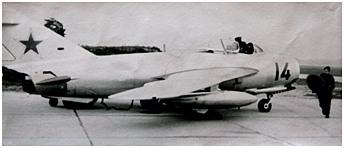 The 1951-1952 period was notable in the unitís history when flying and
technical personnel underwent conversion training to MiG-15bis jet fighters.
In early 1953, the unit received MiG-17 and MiG-17F, which they flew until the beginning of 1962.
September 1953 became yet another important stage in the regimentís fate when it was redeployed to
Damgarten Airfield in the German Democratic Republic as part of the 16th Red banner 'Svirskaya'
Guards Fighter Aviation Division. In October 1956 the unit again changed its location, moving to Wittstock
Airfield and, from September 1961 on, the regiment was registered at Lšrz Airfield. That very year the
19.GvIAP changed its designation. It was converted from a fighter aviation regiment to fighter-bomber
aviation regiment (IBAP).
The 1951-1952 period was notable in the unitís history when flying and
technical personnel underwent conversion training to MiG-15bis jet fighters.
In early 1953, the unit received MiG-17 and MiG-17F, which they flew until the beginning of 1962.
September 1953 became yet another important stage in the regimentís fate when it was redeployed to
Damgarten Airfield in the German Democratic Republic as part of the 16th Red banner 'Svirskaya'
Guards Fighter Aviation Division. In October 1956 the unit again changed its location, moving to Wittstock
Airfield and, from September 1961 on, the regiment was registered at Lšrz Airfield. That very year the
19.GvIAP changed its designation. It was converted from a fighter aviation regiment to fighter-bomber
aviation regiment (IBAP).
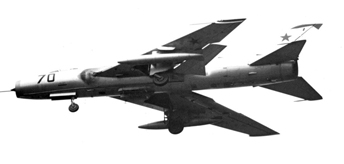 During the second half of February 1962, 19.GvIBAP personnel set about conversion to equipment
more suitable for a fighter-bomber aviation regiment, the Sukhoi Su-7B. Already by the end of the year
thirty-four pilots could fly solo this new aircraft type. The improved Su-7BM version was also introduced into
service during the next years.
During the second half of February 1962, 19.GvIBAP personnel set about conversion to equipment
more suitable for a fighter-bomber aviation regiment, the Sukhoi Su-7B. Already by the end of the year
thirty-four pilots could fly solo this new aircraft type. The improved Su-7BM version was also introduced into
service during the next years.
In 1977, flying and engineering-technical personnel began to assimilate the new MiG-27
third-generation ground-attack aircarft. Major V.S. Pozdeyev became the first sniper pilot in this aircraft type.
The first squadron was equipped with MiG-27K between 1980 and 1988. But the regiment was finally completely
reequipped with MiG-27D models between 1984 and 1988.
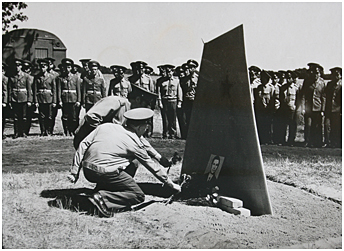 The memorial to Guards Captain Sergey V.Arapov. © A.Pavlov archives.
Unfortunately, the rhythmic life of the regiment did not go on without tragedies. During various
postwar years, the regiment lost several of its best pilots.
The most famous and heroic instance occurred
on May 14, 1982 when flight commander Guards Captain Sergey Viktorovich Arapov died.
The engine of his MiG shut down during takeoff. He could have ejected of the aircraft, but the German village of
Gaarz lay beneath the falling aircraft. Sergey turned the falling aircraft away from the village and, at the
cost of his own life, saved the lives of many German citizens. Sergey was awarded the Order of the Red
Banner posthumously.
The memorial to Guards Captain Sergey V.Arapov. © A.Pavlov archives.
Unfortunately, the rhythmic life of the regiment did not go on without tragedies. During various
postwar years, the regiment lost several of its best pilots.
The most famous and heroic instance occurred
on May 14, 1982 when flight commander Guards Captain Sergey Viktorovich Arapov died.
The engine of his MiG shut down during takeoff. He could have ejected of the aircraft, but the German village of
Gaarz lay beneath the falling aircraft. Sergey turned the falling aircraft away from the village and, at the
cost of his own life, saved the lives of many German citizens. Sergey was awarded the Order of the Red
Banner posthumously.
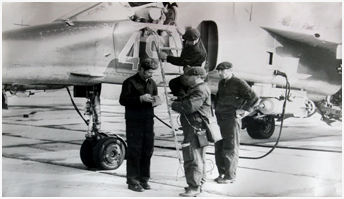 While based in Germany, the 19.GvIBAP (19.GvAPIB from December 1976 on) participated directly in such large Warsaw Pact
exercises as October Storm in 1965, Comrades-in-Arms-70 in 1970, Comrades-in-Arms-80 in 1980 and many
others.
On 15 July 1993, the 125th Red Banner Fighter-Bomber Aviation Division (Rechlin) of which the 19.GvAPIB
was a part ceased combat operations in the former GDR and was withdrawn in full complement to Russia.
It is finally on March 23 that
all the aircraft from the 19.GvAPIB left unified Germany for Millerovo Airfield in Rostov Oblast', where the
Guardsmen awaited another reformation. This time, it was back to fighters. The new fighter regiment retained its
former designation and Combat Banner. The MiG-27D fighter-bombers in the regimentís inventory were
turned over to the BKhAT (aircraft storage base) at Chebeníki, to be replaced by MiG-29 Mod 9-13
fighters.
While based in Germany, the 19.GvIBAP (19.GvAPIB from December 1976 on) participated directly in such large Warsaw Pact
exercises as October Storm in 1965, Comrades-in-Arms-70 in 1970, Comrades-in-Arms-80 in 1980 and many
others.
On 15 July 1993, the 125th Red Banner Fighter-Bomber Aviation Division (Rechlin) of which the 19.GvAPIB
was a part ceased combat operations in the former GDR and was withdrawn in full complement to Russia.
It is finally on March 23 that
all the aircraft from the 19.GvAPIB left unified Germany for Millerovo Airfield in Rostov Oblast', where the
Guardsmen awaited another reformation. This time, it was back to fighters. The new fighter regiment retained its
former designation and Combat Banner. The MiG-27D fighter-bombers in the regimentís inventory were
turned over to the BKhAT (aircraft storage base) at Chebeníki, to be replaced by MiG-29 Mod 9-13
fighters.
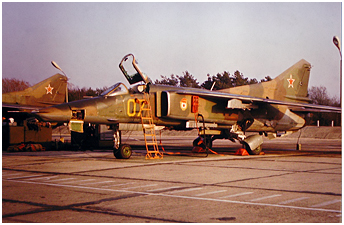 Whereas the regiment had been supplied new aircraft directly from the plant in the past, things
were different in the case of the MiG-29. The aircraft were collected from several units and
airfields: Lipetsk (968th IAP), Zernograd (31st GvIAP), Zherdevka (14.GvIAP and 35.IAP) and
Primorsko-Akhtarsk (960th IAP). In order to retain and multiply the regimentís Guards traditions and
create a special psychosocial atmosphere in the unit, the commander ordered a Guards symbol of a
new Russian form be applied to many of the MiGs.
During the 16 years of existence of the 19th GvIAP in Rostov Oblastí, the regiment felt in full measure
all the ďtrials and tribulationsĒ that engulfed the Russian military during the difficult years of the 1990s.
Whereas the regiment had been supplied new aircraft directly from the plant in the past, things
were different in the case of the MiG-29. The aircraft were collected from several units and
airfields: Lipetsk (968th IAP), Zernograd (31st GvIAP), Zherdevka (14.GvIAP and 35.IAP) and
Primorsko-Akhtarsk (960th IAP). In order to retain and multiply the regimentís Guards traditions and
create a special psychosocial atmosphere in the unit, the commander ordered a Guards symbol of a
new Russian form be applied to many of the MiGs.
During the 16 years of existence of the 19th GvIAP in Rostov Oblastí, the regiment felt in full measure
all the ďtrials and tribulationsĒ that engulfed the Russian military during the difficult years of the 1990s.
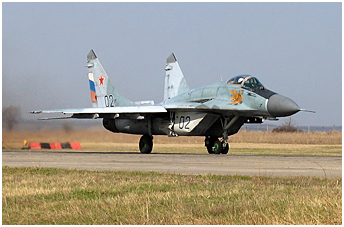 The reminiscences of how the military feverishly suffered from the constant lack of
financing, the shortage of fuel and spare parts for the aircraft are still fresh. At a certain moment all this, plus the
absence of sufficient flying time for the officers, led to a March 2007 accident when two combat fighters were lost
simultaneously - the pilots ejected safely.
But the situation gradually became to improve and in recent years pilots have again begun to fly
actively. Flying training exercises and practical live firing have been resumed. Personnel are developing
combat coordination during training flights. Aircraft that remained on the ground for several years now
have been repaired and one sees them airborne more and more often.
Hopes are that the ongoing process of upgrading Russian
aviation weapons to new modern aircraft will also affect the Guardsmen of Rostov Oblastí soon.
The reminiscences of how the military feverishly suffered from the constant lack of
financing, the shortage of fuel and spare parts for the aircraft are still fresh. At a certain moment all this, plus the
absence of sufficient flying time for the officers, led to a March 2007 accident when two combat fighters were lost
simultaneously - the pilots ejected safely.
But the situation gradually became to improve and in recent years pilots have again begun to fly
actively. Flying training exercises and practical live firing have been resumed. Personnel are developing
combat coordination during training flights. Aircraft that remained on the ground for several years now
have been repaired and one sees them airborne more and more often.
Hopes are that the ongoing process of upgrading Russian
aviation weapons to new modern aircraft will also affect the Guardsmen of Rostov Oblastí soon.
 |
19.GvIAP < Part 1 | > Part 3 |


